This DIY hand sanitizer takes only a few ingredients and just minutes to put together. This easy spray sanitizer recipe can be used on both hands and surfaces.
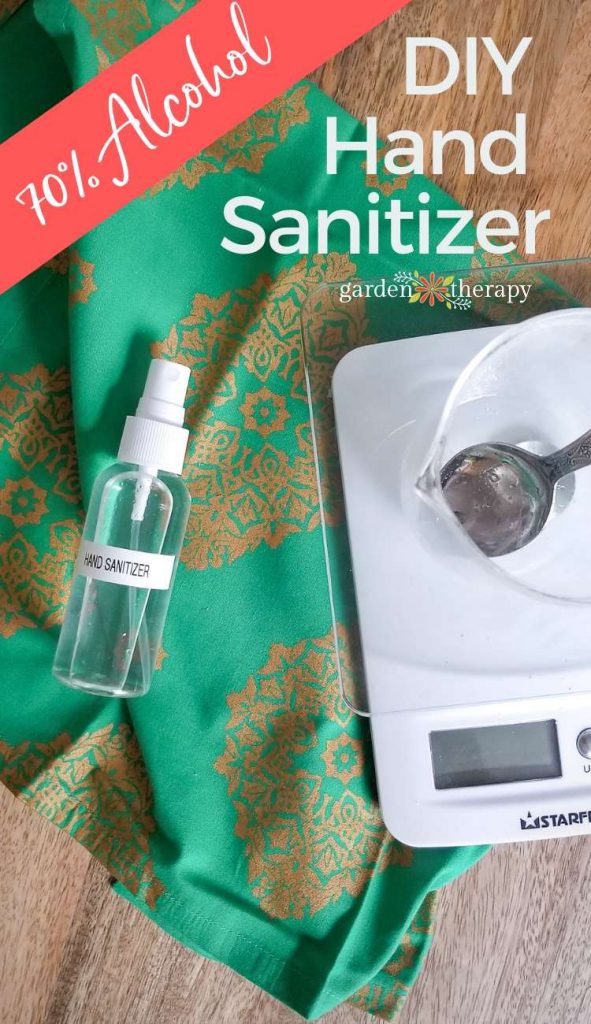
I’ve been seeing a lot of DIY hand sanitizer recipes popping up lately. Many of these are alcohol-based hand sanitizers made with isopropyl alcohol or even vodka.
In the years past, I have researched quite a bit on the proper formulation of sanitizers. If you’ve seen my previous DIY hand sanitizer recipe and recommendations for handwashing as part of the free natural skincare mini-course you’ll know that for years I have been using natural and plant-based soaps and hand sanitizers to keep my hands clean and ward off germs for our family.
And, of course, handwashing has recently been brought into the spotlight.
Thankfully, this has been my regular practice ever since my son started preschool and started coming home with what seems like every virus known to man. It was pretty hard for me not to catch them all with a snuggly and snotty toddler, but once I started being diligent about handwashing and not touching my face with my hands, it reduced the viruses that I caught by about 80%.
It’s also important to note that social distancing, avoiding people who are sick, staying home if you are sick, avoiding unnecessary travel, and using alternative greetings (elbow bumps vs handshakes) and great ways to help stop the spread of viruses.
How to Wash Hands
I know it may seem silly to address the how-to of washing hands, but there’s definitely a right and a wrong way to do it.
First, I always use a natural soap. You won’t find antibacterial soaps in our house because I want to protect the natural microbial biome on our skin.
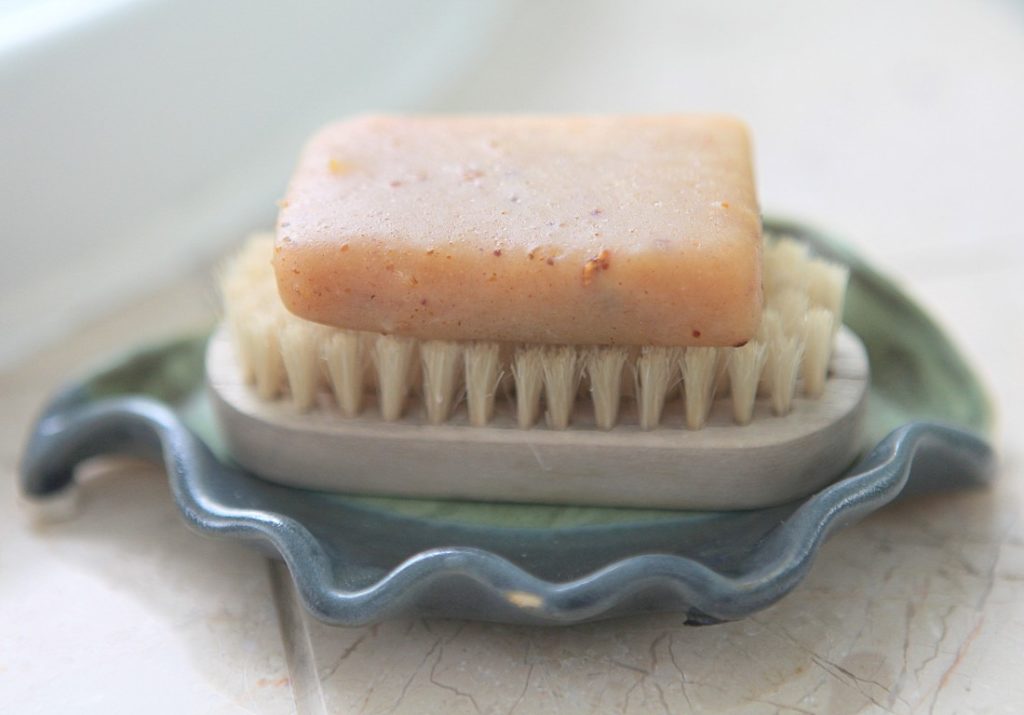
Use a Nail Brush
I do however include a nail brush in my hand washing. The hardest area of your hands to clean is underneath your nails. I use a soft brush like these. I also use a nail brush to hold my soap in the soap dish. This keeps them from sitting in a slimy, gloppy mess and allows the soap to dry and last longer.
I bought a pack of 10 and gave many away as gifts and I have four of them in my home, one in each bathroom, one of the garden sink, and one in the kitchen. Atop each one of these nail brushes is a bar of natural homemade soap.
How to Dry Your Hands Properly
After my hands have been lathered up and rinsed, I dry them well on a clean towel. During cold and flu season, I keep a set of washcloths beside the sink. They can be used once to dry hands then put into a laundry basket and washed before being used again.
Alcohol-Free Hand Sanitizer
When I’m out and about I use my homemade aloe vera hand sanitizer made with thieves oil, a recipe I shared back in 2015. I shake it well every time and apply it liberally to my hands. Then I rub my hands together like I’m washing them and try to wipe them on a napkin or towel. This hand sanitizer does not claim to disinfect or kill viruses but instead to simulate hand-washing when there is no sink nearby.
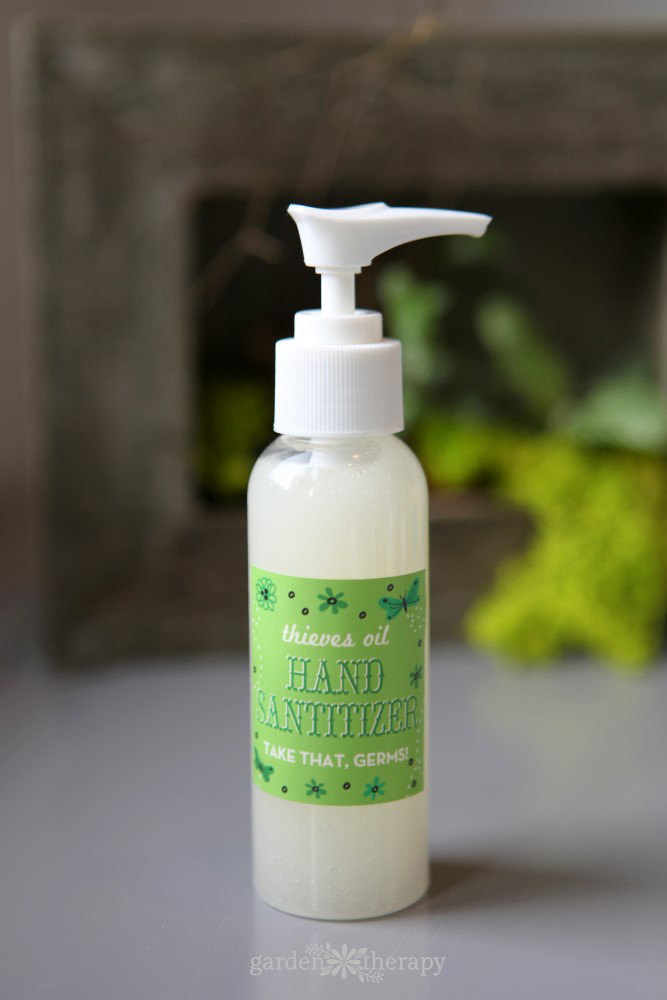
Hand Sanitizer Stockpiling
Stockpiling of hand sanitizers and other essential supplies was not regulated here in Canada. Of concern to me, is that hand sanitizers containing ingredients that have been identified by the FDA as “not generally recognized as safe” are sold out completely in stores because they are being hoarded by people and/or resold at exorbitant prices in secondhand marketplaces like Craigslist and Facebook.
I’m concerned about this behaviour for a couple of reasons.
- Healthy folks bought far more hand sanitizer than they needed, so now it is not available for those who are in most of the need, like those on the front lines, in healthcare and service, and those most at risk.
- These hand sanitizers contain ingredients that are identified as toxic to our bodies. Widespread use of them is not necessarily great for folks. That being said, I do think it’s essential to use these products in healthcare applications where the spread of viruses is a much higher health risk then processing the toxicity out of our systems. Hand sanitizers should be used by all members of the population when visiting hospitals and healthcare facilities, especially where seniors and people who are have health risks are residing.
- Killing off 99.9% of all “germs” does not allow our bodies biomes to encourage the healthy microorganisms that help to protect us in the first place. It leads to the question of what are we opening the door for by killing off everything?
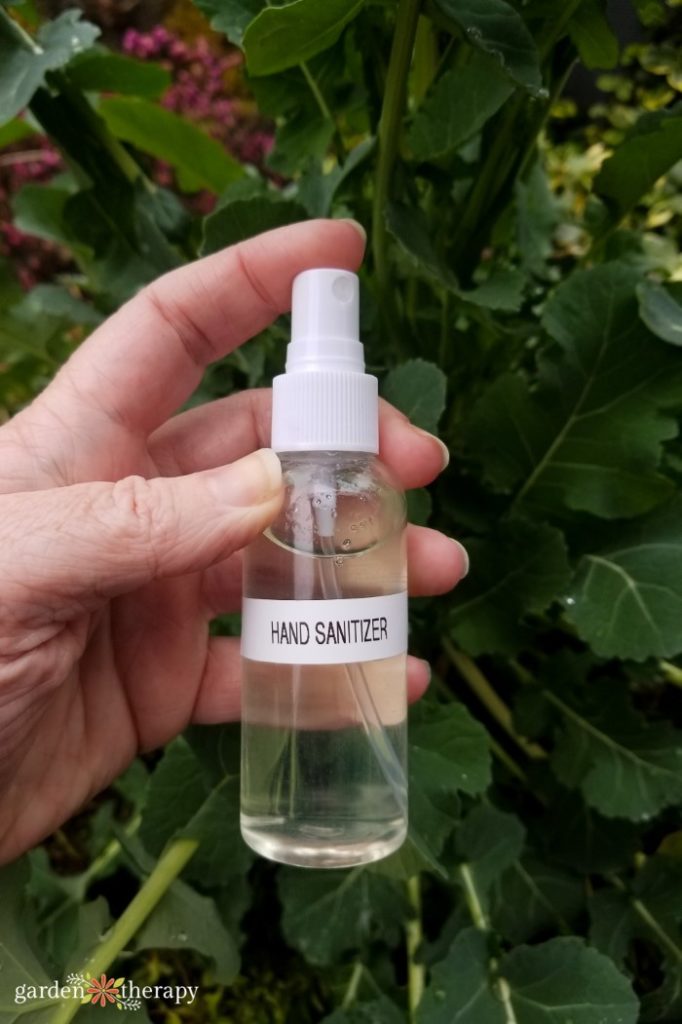
All of that applied before there was an urgent need to protect the population. But as things have developed so rapidly over the past few weeks, I formulated an alcohol-based hand sanitizer to use as a hand and surface spray. For the most part, I will still be hand washing primarily, but when I can’t, I will use this alcohol-based hand sanitizer spray.
This doesn’t mean I will be relying this hand sanitizer to do protect myself and others. Of greater impact, I will be practicing social distancing, avoiding people who are sick, staying home if I become sick, and swapping out handshakes (and hugs) for elbow bumps. I also cancelled the last week of my book tour even though it was within Canada and considered low risk. I feel the best thing I can do now is keep some distance to help flatten the curve.
DIY Hand Sanitizer with Alcohol
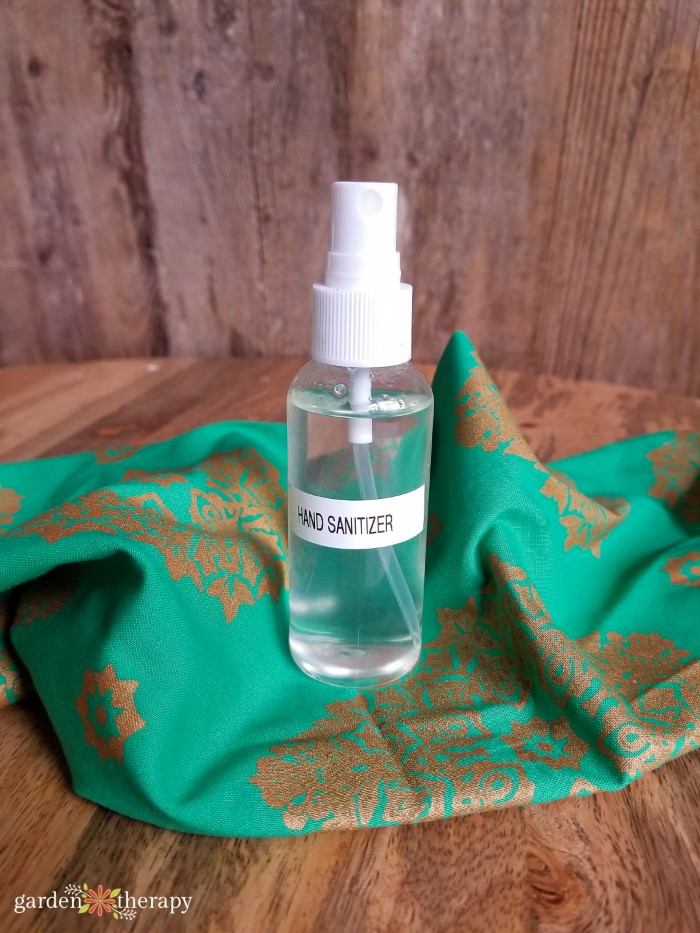
Let’s talk about alcohol. The recommendations are that hand sanitizer formulation needs to be 60% alcohol in order to be effective. I’ve seen different recommendations that range from 60% to 70% so let’s just use 70% of our baseline to be safe.
This does NOT mean that your formulation needs to contain 70% as an ingredient. It means that 70% of the formulation needs to be alcohol. Vodka will not work in this application because it is only 40% alcohol. I’ve seen some formulations that include 70% isopropyl alcohol as just one ingredient in a formulation, but 70% isopropyl alcohol is 70% alcohol and 30% water (and other additives).
On its own, 70% isopropyl alcohol meets the minimum requirements, but this means you can’t combine it with other ingredients in order to make an effective hand sanitizer spray. To make your own hand sanitizer you need the 99% isopropyl alcohol and then you can add 29% of other ingredients like aloe vera, witch hazel, distilled water, hydrosol, and essential oils.
Is Isopropyl Alcohol Safe?
Isopropyl alcohol is most commonly used for sterilization. I use a small amount when formulating lotions and other skincare products to clean my tools and containers. It can also be used in healthcare situations to clean wounds.
In small amounts, there are usually no health issues however it can be toxic when inhaled or absorbed through the skin, and most definitely when ingested. Please DO NOT drink it and if someone has, call medical help immediately. Breathing in the fumes in large amounts can also make you ill.
According to the Skin Deep database, it has a safety rating of 2, meaning it is generally a safe ingredient, but it is noted that it can cause skin irritation. Using it on your hands will certainly cause dryness and extended use could cause dermatitis rashes and cracking. So, if you do plan to use a hand sanitizer with Isopropyl alcohol, please do so with caution, and use it sparingly.
Where to Find Alcohol for Sanitizer
Unfortunately, due to stockpiling, there seems to currently be a shortage of isopropyl alcohol as well. You may not currently be able to find it online, but that will hopefully be shortlived.
Try checking convenience stores, medical supply shops, or even a drug store. You can also ask a grocery store or any other shop when their next shipment of alcohol will be in. Some stores will even reserve a reasonable amount for you – you’ll only need 1 bottle to make several batches of this sanitizer.
How to Make DIY Hand Sanitizer
This is one of the easiest recipes to make. I love that this is a spray sanitizer too – it makes it much easier to use on surfaces as well as hands.
Before we get to the recipe, a quick disclaimer. All my homemade recipes, including this one, have not been tested by any third party and as such should always be used with caution. I recommend spot testing this formulation before widespread use to make sure there are no adverse reactions. While I always do my best to provide useful information, any reliance you place on such information is strictly at your own risk. This post is not a substitute for medical, legal, or any other professional advice of any kind.
Hand Sanitizer Materials

This is what you need to make a 100 ml spray. If you want to make more, you can double the batch and divide into different spray bottles. I like to keep one in my purse and one at home. If you have a diaper bag, you could stash one there as well.
- 75ml Isopropyl alcohol 99%
- 10 ml Witch hazel or Lavender Hydrosol
- 15 ml Aloe Vera gel
- 4 drops each of sweet orange, lavender, and tea tree essential oil
Weigh Your Materials
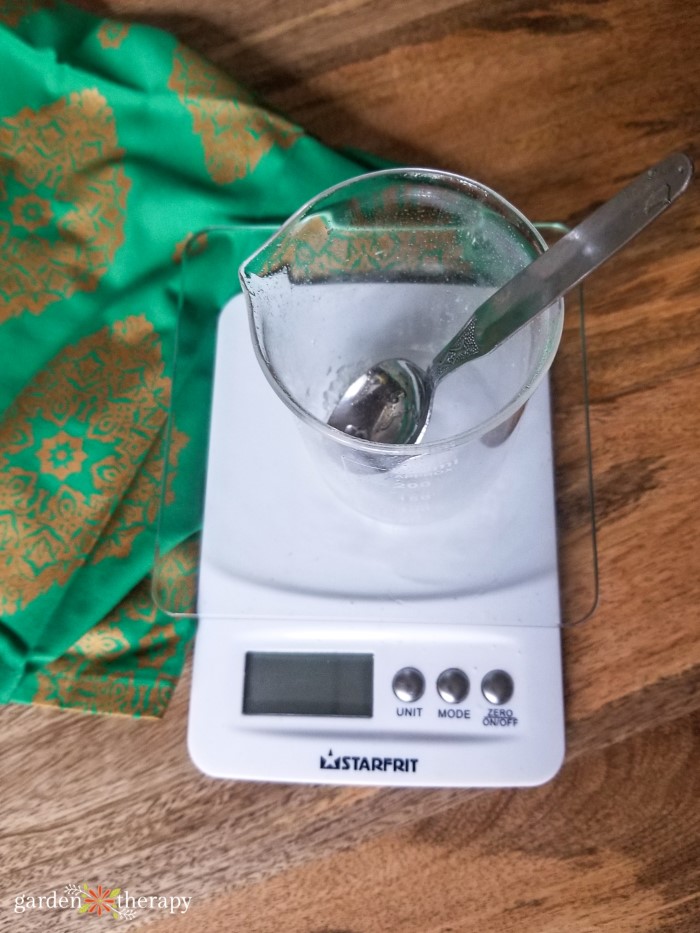
The only way to get a truly accurate measurement of the ingredients is to weigh them. A basic kitchen scale like this one is all you need. You’ll find it’s much easier than using measuring cups too.
Make it:
Using a funnel, add all of the ingredients to a 100ml bottle with an atomizer cap.
Screw the lid back on, and then to combine the ingredients, simply shake well. Make sure to give it another vigorous shake each time before you use it as well.
Whenever you use DIY hand sanitizer spray (or any spray sanitizer for your hands), spray your hands so they are fully covered, rub them together, then let them dry.
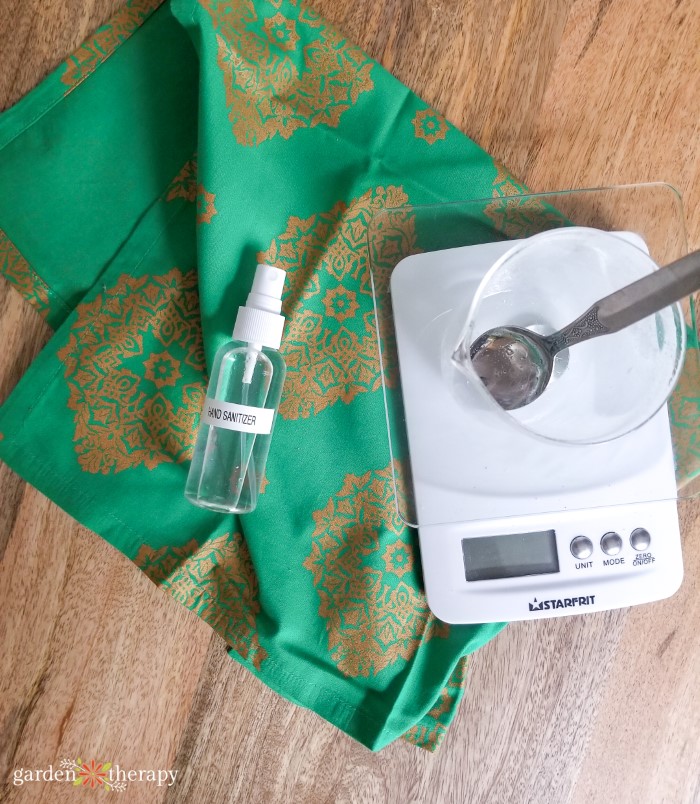
More Posts to Read:
- DIY Eucalyptus Shower Steamers
- Natural Common Cold Remedies
- Herbal Roll-On Remedies for Cold and Flu
- All-Natural Chest Vapor Rub Recipe
DIY Hand Sanitizer Spray
Equipment
Supplies
- 75 ml Isopropyl alcohol 99%
- 10 ml Witch hazel or 10 ml Lavender Hydrosol
- 15 ml Aloe vera gel
- 4 drops Sweet orange essential oil
- 4 drops Lavender essential oil
- 4 drops Tea tree oil
- 1 small funnel
- 1 100 ml glass spray bottle
Instructions
- Measure all ingredients by using a kitchen scale.
- Pour all ingredients into the glass spray bottle, using the funnel.
- Shake well.
Notes

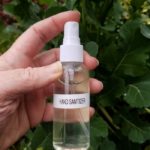



Hi, what would be the shelf life of it?
Hi Gabriel, I usually use the rule of thumb of the shelf life = the ingredients’ shelf life, but in this case the alcohol makes the shelf life indefinite / until it runs out. The other ingredients will start to lose effectiveness over time, so I would use it within 3 months.
Are these ingredients etc CDC approved?
Hi Marsha, that question is answered thoughtfully and thoroughly in the article and supported by the accompanying links, one of which goes to the CDC’s website recommendations.
Thank you so much, I had already purchased plastic bottles will it be ok? Also I went to natural food store to get the essential oils. I got the orange and went to get the other 2. They had a pure tea tree oil and pure lavender mix. The person there said would be fine just use 8 drops. Is this going to be ok or do I need to buy a separate tea tree and lavender oil?
Thank you
Hi Stephanie….. I got a homemade hand sanitizer recipe from a friend and she gave me a bottle of 100% alcohol , so I used 3/4 cup of that , plus 1/3 c. of Aloe Vera Gel and about 20 drops of Lavender EO. That was her recipe. At first I made a batch , but instead of the Aloe Vera Gel, I used Vegetable Glycerin and it turned out great. So, I thought I would try to make it with Aloe Vera Gel and after I added all the ingredients and started mixing a little with a small whisk, then there was this “glop” that formed in the bowl and would not blend in the more I tried to mix it. Was it the Aloe Vera Gel???? This “glop” was about 1/4 cup and I simply removed it and then added some vegetable glycerin instead and it seemed to be okay. What did I do wrong?
Hi Joanne, it definitely takes some regular combining to keep the aloe and the alcohol together. I find that whisking the batch when I make it, and then shaking it every time means they will eventually bond together. Mine doesn’t need shaking after I have been using it for a week. It could also be the aloe gel you have through. I sounds to me like the glycerin is a good option for you.
I put thieves essential oil blend in my hand sanitizers. That or Shield blend.